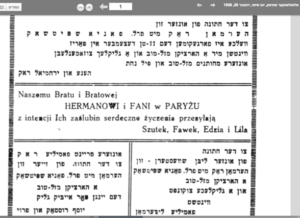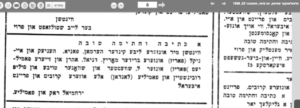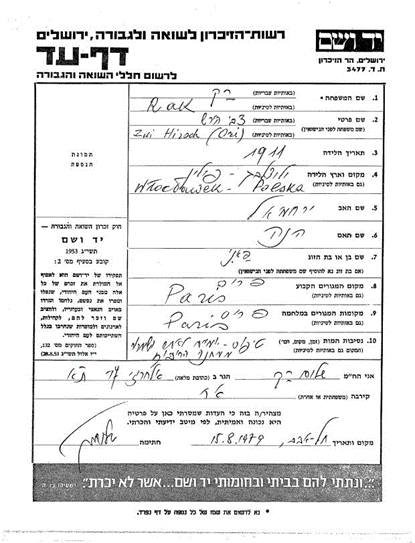Hersh RAK
Our names are Marta and Ola. We are from Wloclawek, a city in central Poland. Before the Second World War it was a multicultural city, with about 65 000 inhabitants, of which 14 or 15,000, about a quarter of the citizens, were Jewish. The city had two synagogues, a Jewish hospital, a Maccabi sports club, the “Jewish Art Scene” association, a Jewish craftsmen’s guild, a Talmud Torah school, a Mizrahi school for boys, a mixed-sexgymnasium for the Jewish Community, private Jewish schools and the Hachomer Hatzaïr youth organization. In the Jewish community of Włocławek were born the future Nobel Prize winner Tadeusz Reichstein and the literary critic Marcel Reich-Ranicki. The local elite also included Jewish doctors, lawyers, merchants and entrepreneurs. Naturally, there were also some middle-class people and a significant number of poor people.
Today, they are no longer there, and neither are their descendants. Most of the places listed no longer exist. We do know, however, where the ghetto used to be. On our way to school, we used to pass by the old Jewish hospital every day, believing that it had always been a dermatology hospital!
In September 2020, we heard about the Convoy 77 project and decided to participate. One meeting after another, we learned more about a man who lived here 100 years ago.
First of all, we learned about the history of Convoy 77. In the group of 1310 deportees, there were about 200 Poles, including our compatriot Hersh Rak. Who was he? Where did he live? What did he do for a living? How did he end up in France?
At one of the meetings, we decided to broaden our knowledge about the convoy itself. We learned that it had left France on July 31, 1944 and that its journey had ended at the Auschwitz-Birkenau extermination camp. Our Hersh was aboard this convoy. At the time of his arrest, he was 33 years old. We learned this from French documents. Among other things, we read that he was born on November 2, 1911 and that his parents were named Rakhmiel and Hannah Mirla.
During a visit to the Jewish Historical Institute, thanks to Ms. Anna Przybyszewska-Drozd and Mr. Matan Shefi, who retrieved an extract from a newspaper dated December 1938, containing the congratulations of Hersh’s brothers and sisters on the occasion of his marriage to Fania, we learned that the wedding had taken place in Paris. Another document specifies that it was December 30, 1938. The vows and congratulations had been signed by Hersh’s brothers and sisters. That is how we got to know their first names: Szutek, Fawek, Edzia and Lila. However, on the Yad Vashem Institute website, we found yet another brother and the birth dates of all the children of Yerakhmiel and Hannah Rak, as well as their own birth dates.
The family history, based on an analysis of all available sources, is as follows:
Hersh (who is mentioned in the documents also under the first names of Herman, Henri and Zvi) was the son of Yerakhmiel (Rakhmiel) Rak born in 1885 in Kutno and Hannah Rak, born Mirla in 1888 at Włocławek. Hersh was born when his father was 26 years old and his mother 23. Everything suggests that Hersh’s grandparents on both parents’ sides lived at Włocławek. They were: on the father’s side, Mordekhaï and Esther, and on the mother’s side, Moshe and Malka. We were able to establish that Rakhmiel Rak died in Auschwitz and Henna at Lodz. Hersh had five brothers and sisters. The three brothers were Hhil (Yekhiel/Volf) Rak (1912), who before the war lived in Paris and was married, Shalom (Shulim/Shulin) Rak (1914), the only one who survived, and Fabush Shraga Rak (1917). There were two sisters, Edzia Esther Rak (1925) and Lilka Lea Rak (1929). All of Rakhmiel and Hena’s children were probably born in Włocławek.
Hersh was married to Fajga Laja Szpiczak, who, when in France, used the first name Fanny. Born in Stryków, she was the daughter of Henock Szpiczak and Chewcia Fefer. They were married on September 26, 1939 in Paris, in the 14th district. Hersh was 28 years old at the time and Fajga 26. Hersh and his brother Yekhiel had moved to France. Hersh was then 27 or 28 years old.
His father Yerakhmiel died in Auschwitz, his mother Henna and the younger children at Lodz, our Hersh in Ebeensee, and his brother Khil was deported from Pithiviers, on Convoy No. 6, and died on July 17, 1942 in Auschwitz.
Shalom (Shulin) Rak was a teacher and survived the war in the USSR. All of this information comes from him.
The French documents also gave us information about Hersh’s home address and profession. He was a merchant, had kept his Polish nationality and lived in the 3rd district of Paris, at 18 rue du Pont-aux-Choux. We checked it out, and found that it is about halfway between the famous Père-Lachaise cemetery and the Louvre. The street and the house with this number still exist today. There is a five-storey building there.
Hersh was also active in the Resistance, under the alias Bourseau, and joined the French Home Forces in 1943. He participated in several missions and held the rank of sergeant. We know that he was active in Creuse department from December 1, 1943 through June 8, 1944. It was then that he was sent to defend the town of Guéret with his troops. He was at that time under the command of Captain Leylaverge and was arrested by the Wehrmacht. He was subsequently interned at Montluçon and then at Drancy, from June 9, 1944 until July 31, 1944. He was held in the Ebensee camp in Austria from the end of July 1944 until March 15, 1945, where he died. We tried to establish for definite that he was not sent to Auschwitz. Unfortunately, we were not able to find out.
At the time of his arrest, he was 32 years old and he died at the age of 34. In a letter to the Ministry dated March 9, 1950, Hersh’s widow, Fania Rak, asked for him to be granted the distinction “Mort pour la France”, or “Died for France “. A letter authorizing the inscription of these words in the Town Hall register arrived on April 24, 1950.
Towards the end of our research into Hersh’s life, we decided to focus again on Shulim Rak, his younger brother, the only survivor. It turned out that at the end of his life he was living in Israel. We obviously wanted to find out as much information as possible about Hersh, so we decided to contact, through the Jewish Historical Institute, the only living family members. We were informed that unfortunately Shalom had died childless 1983, as had his wife a few years later, in 1998.
Despite all our research in the archives, and despite the help of the employees of the Jewish Historical Institute, our visit to the Polin Museum and the town hall in Włocławek as well as our analysis of the French documents, we did not manage to discover all there was to know about our hero. Nevertheless, we feel that we have learned a lot.



Working on this project has been very interesting. Thanks to its coordinator, Mr. Dariusz Łoboda, we were able to visit many places we did not previously know about: the Jewish Historical Institute, the Polin Museum in Warsaw, the Polish National Archives and the Włocławek town archives department.
Through all this, we were able to learn the story of a man about whom we knew nothing before. We became detectives. We discovered a man who was a real hero, we got to know his first name and what happened to his family.
We found out that he was awarded the distinction “Died for France”. He must have been brave! He fought against the Germans because he wanted a better world. He shared the fate of millions of Jews, the fate of his family and the fate of thousands of other people from Włocławek and from Poland.
He has become important to us. Nowadays, we look at our city in a different light.
Ola and Marta
Special thanks to Ms. Aleksandra Engler-Malinowska, Project Coordinator for Poland, Ms. Anna Przybyszewska-Drozd and Mr. Matan Shefi from the Jewish Historical Institute, Ms. Mirosława Stojak from the Town Hall of Włocławek and Mr. Rafał Więckowski from the National Archives of Toruń, Włocławek office.
Bibliography:
Websites consulted:
https://yvng.yadvashem.org/index.html?language=en&
http://meldunkowe.genealodzy.pl/ar17-zs0001d
http://metryki.genbaza.com/genbaza,list,142152,1
Images
Contributor(s)
Marta and Ola, students at the III Liceum Ogolnoksztalcace im. M. Konopnickiej high school in Włocławek, with the guidance of their teacher, Darius Loboda.


 Français
Français Polski
Polski










